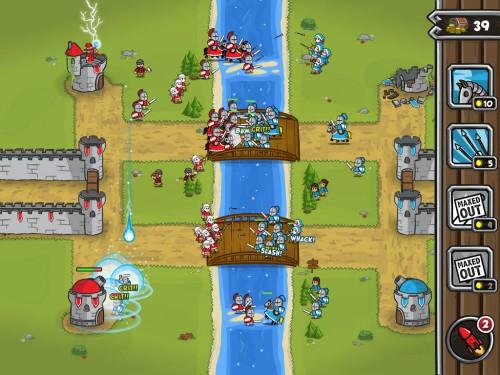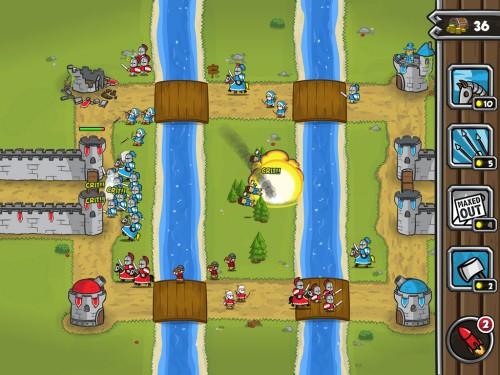- Wondering how to get Monopoly GO! free rolls? Well, you’ve come to the right place. In this guide, we provide you with a bunch of tips and tricks to get some free rolls for the hit new mobile game. We’ll …
Best Roblox Horror Games to Play Right Now – Updated Weekly
By Adele Wilson
Our Best Roblox Horror Games guide features the scariest and most creative experiences to play right now on the platform!The BEST Roblox Games of The Week – Games You Need To Play!
By Sho Roberts
Our feature shares our pick for the Best Roblox Games of the week! With our feature, we guarantee you'll find something new to play!Type Soul Clan Rarity Guide – All Legendary And Common Clans Listed!
By Nathan Ball
Wondering what your odds of rolling a particular Clan are? Wonder no more, with my handy Type Soul Clan Rarity guide.
Castle Raid Review
It doesn’t take much for a colorful, kill-everything-on-screen strategy game to win my affection. Throw in solid touch controls (check), epic music (check), and unique gameplay (check) and I’m sold. So what is Castle Raid missing? Everything else.

Time to storm the Castle of Aaauuuggghhh…
It doesn’t take much for a colorful, kill-everything-on-screen strategy game to win my affection. Throw in solid touch controls (check), epic music (check), and unique gameplay (check) and I’m sold. So what is Castle Raid missing? Everything else.
Castle Raid presents a medieval twist on the tower defense-meets-RTS genre that Trenches introduced in 2009. Unlike Trenches and its side-scrolling ilk, however, Castle Raid takes place on a single screen, bordered on each side by the opposing forces’ strongholds. Although this results in very small characters and icons, the graphics are crisp and differentiating between factions is easy, even on the iPhone.
Your goal is to march your tiny troop of knights from your fortress to the enemy’s, which you’ll have to bash into a pile of bricks in order to win the round. Of course, the opposition is attempting the exact same thing, which means you’ll need to kill any would-be heroes that cross your path.
You’ll start each game with four classes of soldier with which to storm the enemy’s castle: peasants, archers, footmen, and knights. Peasants chop wood to earn gold for purchasing additional soldier units, awarding ten gold per peasant. Archers attack enemies from safe distances, but are weak and slow. Footmen are stronger and faster than archers, but have to fight up close and personal. Knights, the cavalry, are extremely fast and do significant damage, but cost ten gold apiece. These are the only four classes in the game, for you and your opponent, and they cannot be leveled at any point. The only enhancement available is calling in three of the same unit at once, which provides a “Heroic” boost, or strength increase, to that single group.
Once soldiers have left the safety of your castle, they cannot be commanded—they will march in a straight line toward the other side of the screen, venturing off path only to dispatch any enemy that walks within their small field of aggro. To make up for this lack of control, you are provided two support towers that are aimed and shot by you directly: a missile launcher for long-distance, offensive attacks on enemy units, and a magic tower that drops lightning bombs on enemies within range of your own stronghold. Each of these has a recharge period, similar to the units themselves, to prevent spamming what would be a potentially overpowered tool.
This is, in essence, the entirety of Castle Raid. There is no plot, character development, or even gameplay progression to engage you in a game that, on the surface, appears polished and at times charming. These aren’t necessarily required for a game to be fun and addictive, but you usually need some engagement outside of “Here are three game rules. Now play forever,” to warrant a gamer’s time and money.
Outside of the four, and only four, classes that offer no progression whatsoever, the game contains five maps to siege to the death. Each map is almost identical to the last, save the addition of a river and bridge, or—gasp—two rivers and two bridges. The significant change in gameplay caused by a river amounts to: now you should spawn your soldiers near a bridge.
Each of the five maps also features five levels of challenge, ranging from the “’tis but a scratch”-easy “Munch King” and “King Loueé,” to the surprisingly challenging “Evil Empress,” only the third hardest opponent. The jump from Loueé to Empress is staggering, with the latter perfectly shooting your peasants every chance she gets in order to keep your gold, and thus active soldiers, at an absolute minimum.
What all of this—a campaign without goals; units without advancement; an AI with impeccable, devious aim—adds up to is a frustrating, disappointing single-player experience. Thankfully, Arcticmill has included a same-device multiplayer mode that is (almost) its saving grace.
The multiplayer experience plays out exactly the same, even down to the maps, with one critical exception: you’re fighting the person sitting next to you. The computer’s side of the battlefield is replaced by another user interface identical to your own, and the two of you play in real-time without taking turns. The single-player’s shortcomings are mostly resolved in multiplayer, as the focus shifts to the frantic and genuinely fun experience of besting your friend. This is difficult to manage on the iPhone’s smaller screen, but has enormous potential on the iPad and hopefully multi-device multiplayer in the future.
Despite the surprise treat of real-time multiplayer, Castle Raid still feels like an incomplete game. Some players may find the current amount of content enough to warrant the $2 price tag, but I would mark this as a wait-and-see game. Hopefully this is Arcticmill’s Trojan Rabbit, and the great game Castle Raid has the potential to be is just an update away.

The good

The bad
More articles...
Monopoly GO! Free Rolls – Links For Free Dice
By Glen Fox
Wondering how to get Monopoly GO! free rolls? Well, you’ve come to the right place. In this guide, we provide you with a bunch of tips and tricks to get some free rolls for the hit new mobile game. We’ll …Best Roblox Horror Games to Play Right Now – Updated Weekly
By Adele Wilson
Our Best Roblox Horror Games guide features the scariest and most creative experiences to play right now on the platform!The BEST Roblox Games of The Week – Games You Need To Play!
By Sho Roberts
Our feature shares our pick for the Best Roblox Games of the week! With our feature, we guarantee you'll find something new to play!Type Soul Clan Rarity Guide – All Legendary And Common Clans Listed!
By Nathan Ball
Wondering what your odds of rolling a particular Clan are? Wonder no more, with my handy Type Soul Clan Rarity guide.








 “
“ “
“